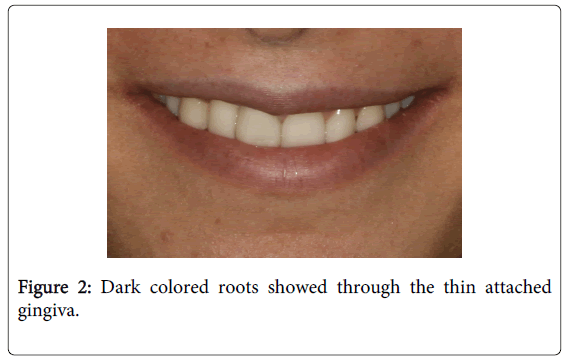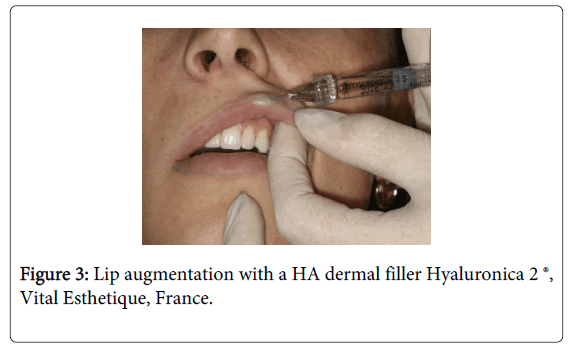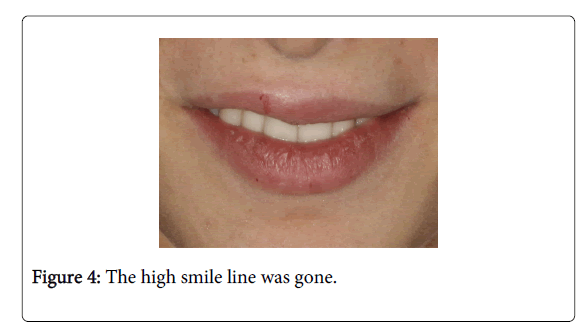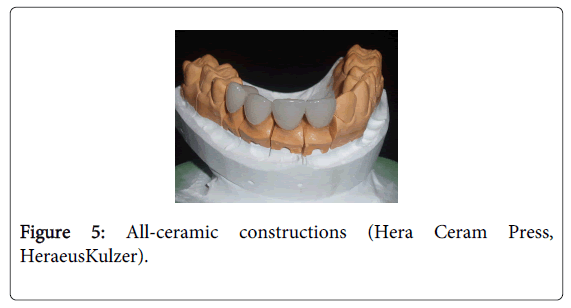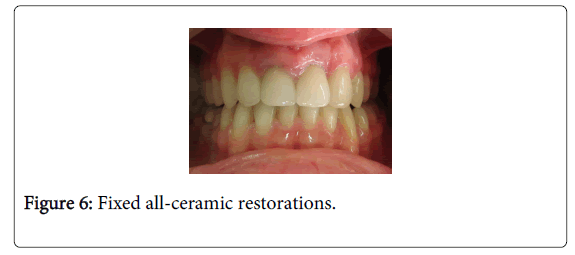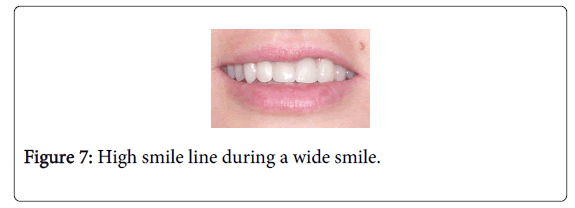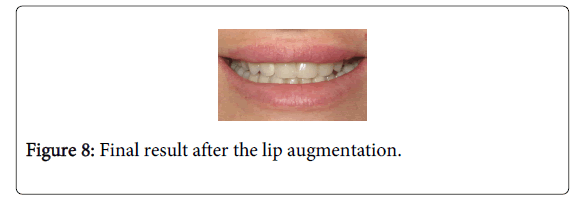Research Article Open Access
Improving the Effect of Aesthetic All-Ceramic Restorations with Hyaluronic Acid Fillers: Clinical Cases
Angelina Vlahova1*, Rada Kazakova1, Christo Kissov1, Elka Popova2 and Georgi Todorov1
1Department of Prosthetic Dentistry, Faculty of Dental Medicine, 3 “Chr. Botev” Blvd., 4000, Plovdiv, Bulgaria
2Department of Periodontology and Oral Mucosa Diseases, Faculty of Dental Medicine, 3 “Chr. Botev” Blvd., 4000, Plovdiv, Bulgaria
- Corresponding Author:
- Angelina Vlahova
Department of Prosthetic Dentistry
Faculty of Dental Medicine, 3 “Chr. Botev” Blvd.
4000, Plovdiv, Bulgaria
Tel: +359888773670
Fax: +35932632687
E-mail: a_vlahova@yahoo.com
Received date: March 15, 2014; Accepted date: July 11, 2014; Published date: July 18, 2014
Citation: Vlahova A, Kazakova R, Kissov C, Popova E, Todorov G (2014) Improving the Effect of Aesthetic All-Ceramic Restorations with Hyaluronic Acid Fillers: Clinical Cases. J Interdiscipl Med Dent Sci 2:134. doi:10.4172/2376-032X.1000134
Copyright: © 2014 Vlahova, et al. This is an open-access article distributed under the terms of the Creative Commons Attribution License, which permits unrestricted use, distribution, and reproduction in any medium, provided the original author and source are credited.
Visit for more related articles at JBR Journal of Interdisciplinary Medicine and Dental Science
Abstract
Background: The Aesthetic Prosthodontics is a part of the Aesthetic Medicine. So called “gummy” smile is an excessive display of gum tissue in the upper jaw during smiling and it is a big aesthetic problem for most of the patients.
Purpose: The aim of this study is to illustrate two clinical cases of aesthetic all-ceramic restorations in a combination with hyaluronic acid (HA) filler lip augmentation for reduction of “gummy smile”.
Methods: Two clinical cases of young women after aesthetic all-ceramic restorations of the upper frontal teeth in combination with dermal filler injection for lip enhancement were described.
Results: The use of linear threading (retrograde) technique with HA dermal fillerfor lip contour shaping and for lip volume augmentation was exceptionally beneficial for the improving the effect of the aesthetic restorations.The final results were satisfying for the patients. They received harmonious, attractive appearance and their quality of life was improved.
Conclusions: Use of dermal fillers for facial rejuvenation in particular for lip augmentation can be successfully used for improvement of the effect of aesthetic fixed prosthetic constructions of women with high or medium smile line.
Keywords
Aesthetic all-ceramic restorations; Hyaluronic acid; Lip augmentation
Abbreviations
HA: Hyaluronic Acid
Introduction
The Aesthetic Dentistry is a part of the Aesthetic Medicine. Usually dental prosthetic constructions are applied when dental tissues are damaged or one and more teeth are missing. Aesthetic prosthodontics performs a slightly different function – it is usually done in the area of the frontal teeth in order to adjust their shape, color, position or to close the gaps between them. Modern dental materials used for aesthetic dental restorations have optical and mechanical characteristics that are very similar to natural teeth. Metal-free ceramics and zirconium oxide restorations look great, because their color can be perfectly adapted to the natural teeth. Also they are durable and wear-resistant. Today, instead of crowns and bridges with a metal substructure, silica, aluminum or zirconium oxides are more preferable.
The “white” aesthetics achieved by all-ceramic prosthetic constructions is inextricably bound up with the “red” aesthetics – the optimal position and condition of the gums. The symmetric smile thatis a combination between proper arranged teeth and a healthy gingiva, cannot be achieved without the frame of the lips. So called “gummy” smile is an excessive display of gum tissue in the upper jaw during smiling and it is a big aesthetic problem for most of the patients. Sometimes the periodontal surgery methods are not enough for correction of such condition. The use of dermal fillers for lip augmentation in these cases can be very helpful [1].
Dermal fillers have become an integral part of any aesthetic physician’s intervention. According to Allemann and Baumann [2] the first dermal fillers used in the 1980s were animal-derived collagen fillers (Zyplast®,Zyderm®, Allergan). However, the need of productswith longer clinical duration and no requirements for prior skin allergy testing lead to the development of the hyaluronic acid (HA) fillers. Of the two biologic fillers currently used – collagen and HAs – HAs have become the new gold standard, and have almost replaced collagen fillers [3]. This is explained by the advantages of HAs over collagen, such as its longer duration (6–12 months compared with 2–4 months), no request for skin testing, fewer allergic side effects and better pliability. A third group of dermal fillers currently used are synthetic fillers, such as Sculptra® (Dermik Laboratories, Sanofi -Aventis, Bridgewater, NJ), Radiesse® (BioForm Medical, San Mateo, CA), and Artefill® (Artes Medical, Inc., San Diego, CA).
HA, or hyaluronan, by definition, is a glycosaminoglycan which consists of regular repeating non-sulfated disaccharide units of glucuronic acid and N-acetylglucosamine [4]. HA is a naturally occurring substance, a biopolymer, which exhibits no species and no tissue specificity. HA is an essential component of the extracellular matrix of all animal and human tissues and is an abundant component of this matrix. HA is highly hydrophilic, that is, itattracts water, and this helps it form large concentrations that can occupy a large volume relative to its mass. It has been shown to form gels at even low concentrations. When water is drawn into the HA matrix, it has been shown to create a swelling pressure or turgor that enables the HA complex to withstand compressive forces. Thus it has been found useful as filler in treating some of the signs of aging and for tissue augmentation [5].
The first HA developed as a dermal filler was in1989 by Balazs [6], who understoodthe biocompatibility of this class of compounds and lack of immunogenicity. The product was not long lasting, but the revolution had begun [7].
The aim of this study is to illustrate two clinical cases of aesthetic prosthetic constructions in a combination with HA filler lip augmentation for reduction of “gummy smile”.
Materials and Methods
The first clinical case is of a young lady, 27-years old, who went through aesthetic reconstruction of the first and second upper right incisors (11 and 12) with all-ceramic crowns made of e.max Press, IvoclarVivadent (Figure 1). As a result of previous endodontic treatment of the two teeth their roots were dark colored and showed through the thin attached gingiva during a wide smile, because the patient was with high smile line (Figure 2). This fact decreased the aesthetic effect of the restorations. We made lip augmentation with HA dermal filler Hyaluronica 2®, Vital Esthetique, Franceto correct that (Figure 3). We used Linear Threading (retrograde) technique for lip contour shaping and for lip volume [8]. The final result was satisfying for the patient because the “gummy” smile was gone (Figure 4).
The second clinical case is of a 32-years old lady after aesthetic reconstruction of the upper frontal teeth with all-ceramic constructions, made of Hera Ceram Press (HeraeusKulzer) (Figure 5). The patiententral incisors were restored with two crowns, the left canine was transformed into a lateral incisor by means of laminate veneer and the left first premolar was turned into a canine by a crown, because she had no natural left lateral incisor (Figure 6). This clinical case was similar to the previous one because the central incisors of the patient were devitalized and their colored roots could be seen through the thin attached gingiva in spite of previously made periodontal surgery for crown lengthening. The patient wanted to eliminate the “gummy smile” during a wide smile (Figure 7) so we also made her lip augmentation using the retrograde injection technique [8] witha HA dermal filler Hyaluronica 2®, Vital Esthetique, France. She was pleased with the final result (Figure 8).
Results and Discussion
“Gummy smile” is associated with an over exposure of the gingival margin during smile. The upper lip elevates too far above the upper teeth causing excessive gingival display. The cause of this is either a hyperactive muscle around the mouth which then elevates the upper lip or a thin upper lip.The physician should discuss the relative merits of fillers and other competing or complementary treatments (for example, botulinum toxin type A [BOTOX®] and surgery), duration of effect, and benefits and risks of each option [9].
In the first case one of the treatment methods is with expertly positioned injections using Botulinum Toxin Type A such as Botox. The results from this treatment usually last approximately three months.If the gummy smile is due to a thin upper lip, then the lip can be enhanced by using a hyaluronic acid (HA) dermal filler such as Hyaluronica 2®, Juvederm Ultra, etc. This treatment can be performed under a dental anesthesia to make the procedure pain free. Results usually last approximately six months.
The simplest way to classify the smile line—using the relationship between the maxillary incisors and the upper lip—is through height (low, medium, and high). The ideal for the height of the smile line is to be classified using as a reference the relationship between the lower edge of the upper lip and the gingival edge of the maxillary central incisor. However, a 2 mm limit should be established above and below the gingival edge, thus instituting the three classes of smile height: high, medium, and low. As such, a positive aspect is that, with a 4 mm difference, the differentiation of high and low smiles—the smile types that lead patients to seek treatment—is clinically facilitated. Moreover, a numeric differentiation is created among the heights, making it easier to measure their classification [10].
Linear threading [11] is a technique in which the needle is inserted into the skin and the filler is deposited in a linear fashion along the track as the needle is slowly withdrawn. Because this creates essentially a tunnel of filler, this is also commonly referred to as the tunneling technique. Injection for lip augmentation is typically done with a linear threading (for lip contour and volume) or a serial puncture technique (for volume), proceeding from medial to lateral. Along the red lip, the targeted level for filler placement is within the submucosa just above the orbicularis oris muscle. In many cases, a layered distribution helps to provide fuller, more uniform enhancement. Also light massage is recommended after injection for that reason.
The use of linear threading (retrograde) technique with HA dermal filler (in this clinical cases Hyaluronica 2®, Vital Esthetique, France) for lip contour shaping and for lip volume augmentation was exceptionally beneficial to the improvement of the effect of the aesthetic all-ceramic restorations. We chose Hyaluronica 2 instead of Hyaluronica 1 HA filler because of its high viscosity and slower resorption, facts that make it an optimum decision for lip contouring and enlargement. The final results were satisfying for the patients. They received harmonious, attractive appearance and their quality of life was improved.
Conclusions
Use of dermal fillers for facial rejuvenation has become popular because these treatments provide desirable aesthetic outcomes such as a harmonious, attractive appearance without invasive surgical procedures. When they are performed by a skilled physician and with the use of the appropriate filler for the specific application, soft tissue augmentation provide predictable and consistent results. These procedures can be successfully used for improving the effect of aesthetic fixed prosthetic constructions of women with high or medium smile line.
References
- Goldstein R (1997) Change your smile. (3rd edn), Quintessence Publishing Co.
- BogdanAllemann I, Baumann L (2008) Hyaluronic acid gel (Juvéderm™) preparationsin the treatment of facial wrinkles and folds. ClinInterv Aging 3: 629–634.
- Cosmetic Surgery National Data Bank Statistics (2005) Los Alamitos (CA):American Society of Aesthetic Plastic Surgery [online]. Accessed 2006Jun 7.
- Bruce Alberts, Alexander Johnson, Julian Lewis, Martin Raff, Keith Roberts, et al. (2002). The molecular biologyof the cell. Cell junctions, cell adhesion, and the extracellular matrix.1065. New York: Garland Science.
- Gold M (2007) Use of hyaluronic acid fillers for the treatmentof the aging face. Review. Clinical Interventions in Aging 2: 369–376.
- Balazs EA, Denlinger J (1989) Clinical uses of hyaluronan. Ciba FoundSymp 143: 265.
- Beer K (2009) Dermal Fillers and combinations of fillers for facial rejuvenation. DermatolClin 27: 427–432.
- Haj S (2011) Mutovkina M. Master Book. The techniques for physicians. Vital Esthetique, France pp. 4, 6.
- Smith K (2008) Reversible vs. nonreversible fillers in facial aesthetics: Concerns and considerations. Dermatology Online Journal 14 : 3.
- Camara C (2010) Aesthetics in Orthodontics: Six horizontalsmile lines. Dental Press J Orthod 15:1.
- Hilinski J, Cohen S (2009) Volumetric use of injectable fillers in the face. Techniques in Aesthetic Plastic Surgery Series: Facial Rejuvenation with Fillers with DVD: 7-9.
Relevant Topics
- Cementogenesis
- Coronal Fractures
- Dental Debonding
- Dental Fear
- Dental Implant
- Dental Malocclusion
- Dental Pulp Capping
- Dental Radiography
- Dental Science
- Dental Surgery
- Dental Trauma
- Dentistry
- Emergency Dental Care
- Forensic Dentistry
- Laser Dentistry
- Leukoplakia
- Occlusion
- Oral Cancer
- Oral Precancer
- Osseointegration
- Pulpotomy
- Tooth Replantation
Recommended Journals
Article Tools
Article Usage
- Total views: 14650
- [From(publication date):
August-2014 - Apr 02, 2025] - Breakdown by view type
- HTML page views : 9984
- PDF downloads : 4666


